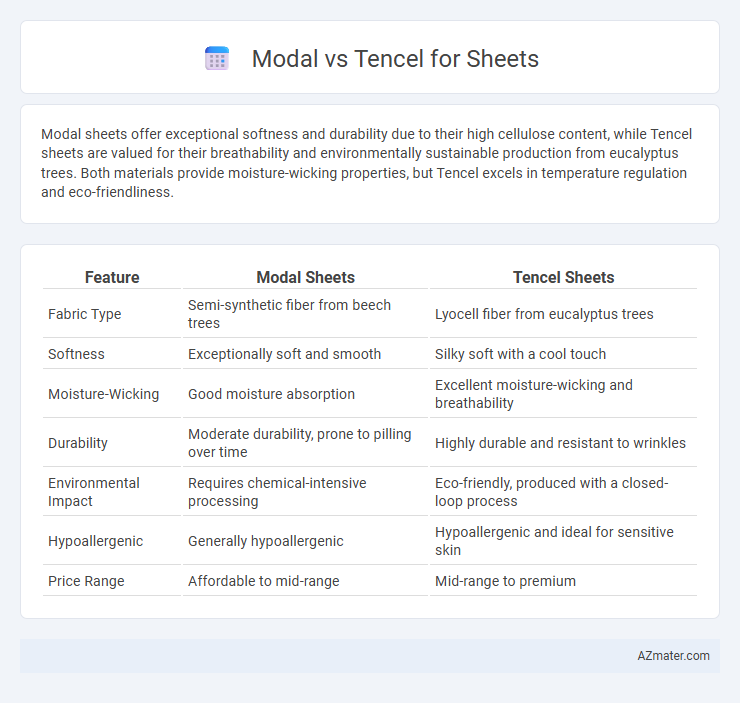Modal sheets offer exceptional softness and durability due to their high cellulose content, while Tencel sheets are valued for their breathability and environmentally sustainable production from eucalyptus trees. Both materials provide moisture-wicking properties, but Tencel excels in temperature regulation and eco-friendliness.
Table of Comparison
| Feature | Modal Sheets | Tencel Sheets |
|---|---|---|
| Fabric Type | Semi-synthetic fiber from beech trees | Lyocell fiber from eucalyptus trees |
| Softness | Exceptionally soft and smooth | Silky soft with a cool touch |
| Moisture-Wicking | Good moisture absorption | Excellent moisture-wicking and breathability |
| Durability | Moderate durability, prone to pilling over time | Highly durable and resistant to wrinkles |
| Environmental Impact | Requires chemical-intensive processing | Eco-friendly, produced with a closed-loop process |
| Hypoallergenic | Generally hypoallergenic | Hypoallergenic and ideal for sensitive skin |
| Price Range | Affordable to mid-range | Mid-range to premium |
Introduction to Modal and Tencel Sheets
Modal sheets are crafted from beech tree fibers, offering exceptional softness, breathability, and moisture-wicking properties that enhance sleep comfort. Tencel sheets, made from sustainably sourced eucalyptus wood pulp, provide a smooth, durable fabric with excellent temperature regulation and hypoallergenic qualities. Both Modal and Tencel sheets are eco-friendly options, combining luxury and performance for a restful night's sleep.
What Is Modal?
Modal is a type of semi-synthetic fabric made from beech tree pulp, known for its exceptional softness and high moisture-wicking properties. It offers excellent breathability and durability, making it ideal for bed sheets that stay comfortable and cool throughout the night. Compared to other fabrics, Modal sheets resist shrinking and fading, providing long-lasting color and smoothness.
What Is Tencel?
Tencel is a sustainable fabric made from wood pulp, primarily derived from eucalyptus trees, known for its eco-friendly production process and biodegradability. It offers exceptional moisture-wicking properties, breathability, and a silky smooth texture, making it ideal for bed sheets that promote comfort and temperature regulation. Compared to Modal, Tencel demonstrates superior durability and a more environmentally responsible manufacturing process, appealing to consumers seeking both softness and sustainability in bedding.
Fiber Source and Sustainability
Modal sheets are made from beech tree pulp, harvested from sustainably managed forests, offering a renewable fiber source with responsible forestry practices. Tencel sheets use lyocell fibers derived from sustainably sourced eucalyptus trees, processed in a closed-loop system that recycles water and solvents to minimize environmental impact. Both fibers provide eco-friendly options, but Tencel's production emphasizes greater sustainability through efficient resource use and biodegradability.
Softness and Feel Comparison
Modal sheets offer exceptional softness with a smooth, silky feel that drapes effortlessly, providing a luxurious touch against the skin. Tencel sheets, made from eucalyptus fibers, boast a naturally silky texture combined with breathability that enhances coolness and moisture-wicking properties. Both materials outperform traditional cotton in softness, but Modal tends to feel richer and more supple, while Tencel is praised for its crisp, cool smoothness and eco-friendly benefits.
Breathability and Moisture Wicking
Modal sheets offer superior breathability due to their fine fiber structure, allowing better air circulation and temperature regulation during sleep. Tencel sheets excel in moisture-wicking properties, efficiently drawing sweat away from the skin to keep sleepers dry and comfortable. Both fabrics provide exceptional softness, but Tencel's advanced moisture management makes it ideal for hot or humid climates.
Durability and Longevity
Modal sheets offer exceptional durability due to their high wet strength and resistance to shrinkage and pilling, ensuring long-term performance. Tencel sheets, made from lyocell fibers, provide superior longevity with enhanced moisture-wicking properties and natural resistance to wrinkles and wear. Both Modal and Tencel sheets maintain softness over time, but Tencel generally outperforms in eco-friendly durability and sustained fabric integrity.
Environmental Impact
Modal and Tencel sheets are both made from sustainable wood fibers, with Tencel derived from eucalyptus and Modal from beech trees, but Tencel boasts a more eco-friendly production process using less water and energy. Tencel's closed-loop manufacturing recycles over 99% of solvents, significantly reducing environmental pollution compared to Modal, which has a less efficient chemical recovery system. Both fibers are biodegradable and biodegradable, yet Tencel sheets typically result in a lower carbon footprint and reduced water consumption, making them a preferable choice for environmentally conscious consumers.
Care and Maintenance
Modal sheets require gentle washing with mild detergent in cold or warm water to maintain fabric softness and prevent shrinking, and they should be air-dried or tumble-dried on low heat to avoid damage. Tencel sheets demand similar care, with machine washing in cold water using eco-friendly detergent recommended to preserve the lyocell fibers' durability and moisture-wicking properties; tumble drying on low or line drying is preferred to prevent fiber weakening. Both fabrics benefit from avoiding bleach and fabric softeners to sustain their smooth texture and longevity in bedding applications.
Which Sheet Is Right for You?
Modal sheets offer exceptional softness and breathability, making them ideal for those who prioritize comfort and moisture-wicking properties in their bedding. Tencel sheets excel in durability and eco-friendliness, featuring natural fibers that regulate temperature and resist wrinkles, perfect for environmentally conscious sleepers seeking long-lasting quality. Choosing between Modal and Tencel sheets depends on whether you value ultra-soft texture or sustainable performance for your specific sleep needs.

Infographic: Modal vs Tencel for Sheet
 azmater.com
azmater.com